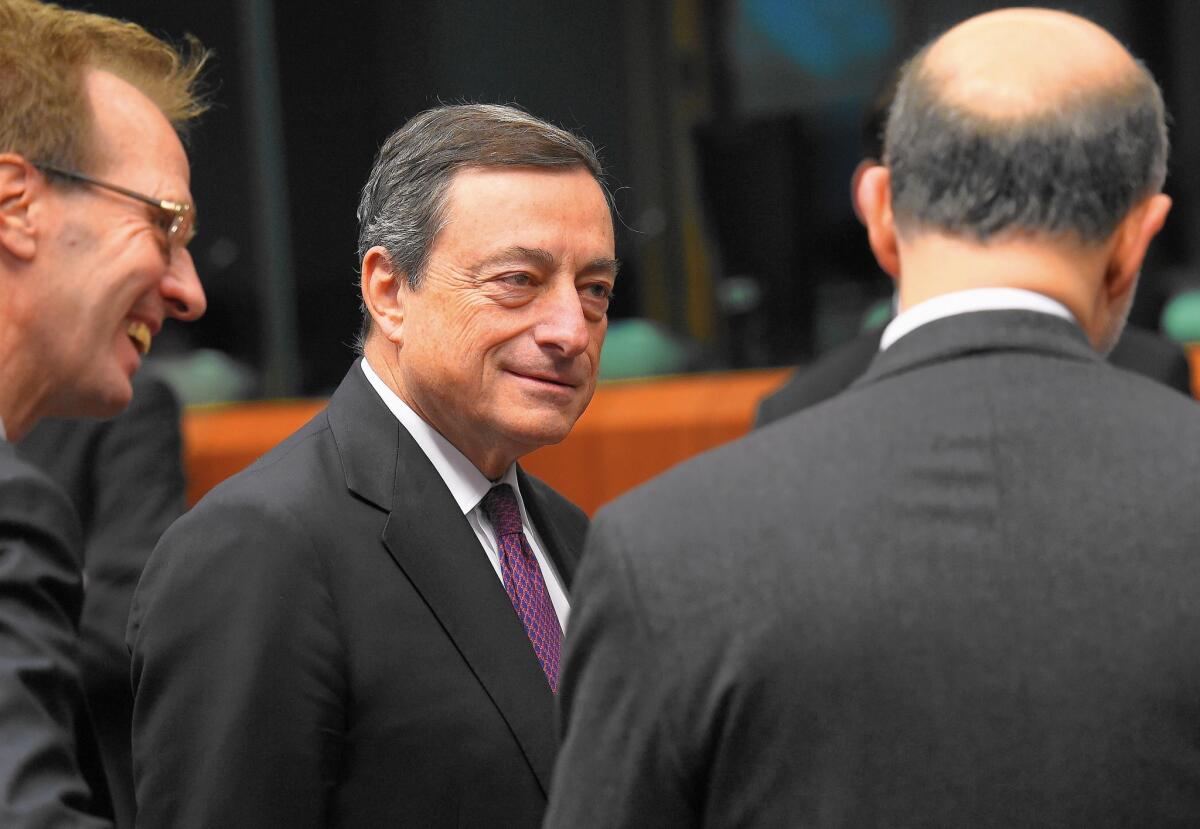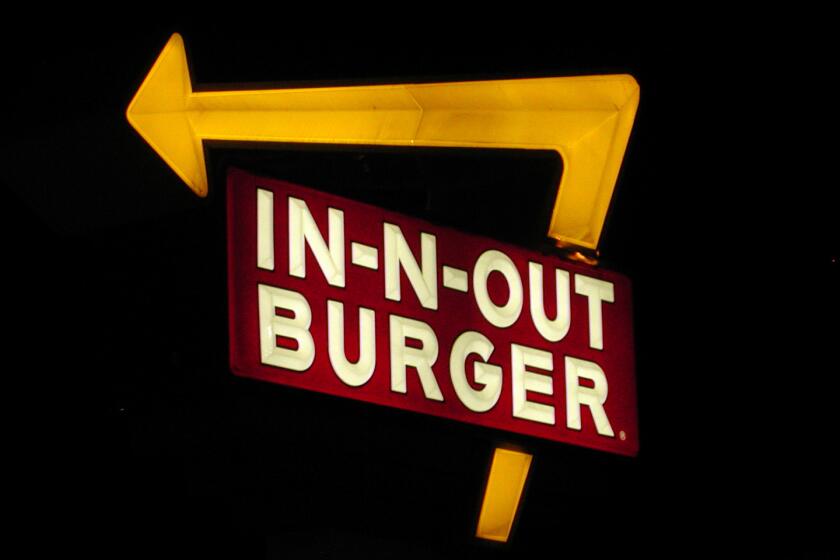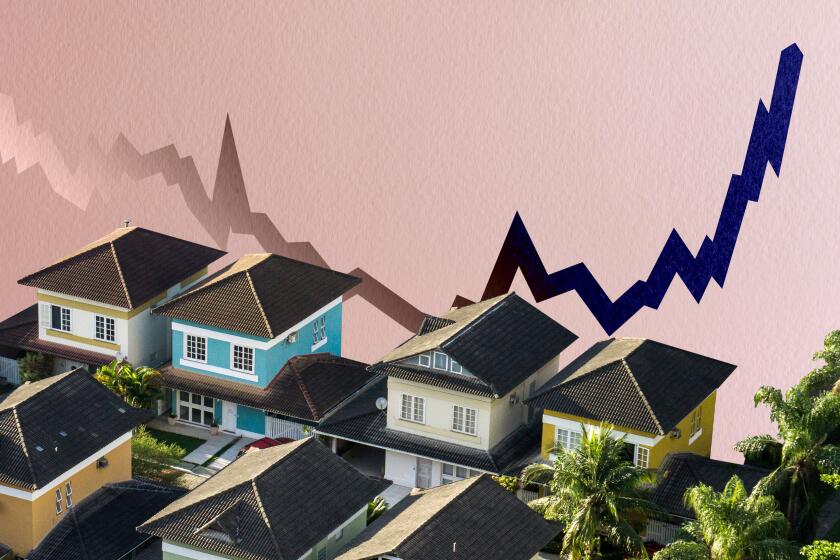Deflation fears rock markets again but consumers see windfall -- for now

- Share via
For the fourth time in 12 years, the world is facing a deflation scare. And as with any good horror movie, no one is sure what lurks in the shadows.
Since summer, slowing growth in China and severe weakness in Europe and Japan have deepened fears that the global economy could tip into deflation — a sustained period of falling prices for goods and services. Those concerns mushroomed in October as crude oil prices collapsed and nervous investors poured into the relative safety of government bonds, driving yields on some bonds to record lows.
The new year kicked off with another dive in oil prices and bond yields and a slump in stock prices. The Dow Jones industrial average lost 0.5% last week, while the yield on Germany’s 10-year bonds fell to an unprecedented 0.43%.
After a lifetime of fearing runaway inflation, some investors now worry that the greatest threat is the opposite: shrinking prices that could undermine wages and the value of real estate, stocks and other assets.
But if deflation takes hold, it would mean different things — good and bad — to different consumers, workers and investors.
Japan, after all, had been stuck in a deflationary rut since the late 1990s. The nation still is wealthy by global standards and its society hasn’t collapsed. Unemployment is a low 3.5%.
And while financial markets have been jolted by the crash in oil prices, consumers worldwide are loving it. In April, it cost $44 to fill a 12-gallon tank. Now it costs $26 with gasoline at $2.17 a gallon, on average, nationwide.
That’s “good deflation” that can help rather than hurt most economies, said Mohamed El-Erian, chief economic advisor to financial services giant Allianz. It’s a direct benefit for consumers, “including lower-income segments who have not shared in any meaningful way in the post-2008 global financial crisis recovery,” he said.
For investors, anyone holding substantial cash savings would welcome deflation if it meant a chance to buy real estate or stocks at significantly lower prices — as some did when housing and stock prices crumbled during the financial crisis.
Yet to many Americans, the idea of ongoing deflation in everyday prices may sound laughable given the cost of food, healthcare, tuition and other goods and services in recent years while wages have stagnated.
The U.S. consumer price index rose only 1.3% year over year in November. But much of the recent weakness stemmed from the fall in energy costs. By contrast, the cost of food was up 3.2% year over year in November, while housing was up 3% and medical care was up 2.3%.
Still, the overall CPI has been declining in fits and starts since late 2011.
In Europe, the epicenter of global economic jitters at the moment, European Central Bank President Mario Draghi conceded this month that deflation “cannot be ruled out completely,” although he said the risk was “limited.”
Central banks and governments don’t fear periodic bouts of very low inflation, and they welcome the kind of deflation that technology is famous for, as innovation brings more computing power at ever-lower prices. But policymakers blanch at the thought of broad, sustained deflation in times of economic weakness because of memories of the Great Depression.
The worst-case scenario: A financial crash causes demand for goods and services to fall as worried consumers and businesses cut spending. As demand dries up, prices drop. That slashes businesses’ sales and earnings, triggering widespread job and pay cuts. Demand for goods and services weakens further, prices fall again and a vicious spiral ensues.
That was the recipe for depression after 1929. The U.S. consumer price index sank as much as 10.3% in 1932 as the economy collapsed.
After the financial crash of 2008, the U.S., Europe and Japan fell into deflation. But prices in the U.S. and Europe quickly began to rebound later in 2009 after stimulus spending programs and easy-money policies stabilized confidence and pumped cash into the battered financial system.
Ben S. Bernanke, the Federal Reserve chairman during the financial crisis, had given a speech in 2002 about the perils of deflation and how to “make sure it doesn’t happen here.” That became the blueprint for the Fed’s extraordinary response after the crash, including cutting short-term interest rates to near zero.
Japan finally escaped deflation in 2013 after the new government engineered a massive stimulus program in concert with the Bank of Japan.
Yet in all three economies, inflation rates are falling once again. Europe in December slid into outright deflation, with the 19-nation eurozone inflation index down 0.2% from a year earlier — the first decline since 2009, the Eurostat agency reported last week.
The possibility of a global deflationary bust has accelerated a rush by investors into government bonds of the world’s biggest economies, including Germany, the U.S. and Japan, driving yields dramatically lower.
Some investors are so fearful that they are accepting “negative” interest rates on shorter-term bonds of Germany, France and Japan, among others. That means investors are in effect paying for the privilege of keeping money in the securities, figuring to at least get their principal back.
As for stocks, the Stoxx 600 index of European blue-chip shares has swung wildly since mid-2014, and is down 1.4% already this year.
But some experts believe that bond investors, in particular, are overreacting to deflation risks. Negative bond yields today “do seem to defy rationality,” said Lee Ohanian, an economics professor at UCLA who has written extensively on the Great Depression and government economic policies.
Jeffrey Rosenberg, chief investment strategist for fixed income investing at money management titan BlackRock Inc., said the dive in bond yields in Europe may not reflect expectations of extended deflation, but rather expectations that the ECB will copy what the Fed did with its “quantitative easing” policy in the U.S.
“I’m not sure the market is telling you something about deflation, or just about its conviction about the ECB’s next step,” Rosenberg said. The central bank is expected to announce a massive bond-buying program on Jan. 22, which could make outstanding bonds more valuable.
Rosenberg believes sustained global deflation is “very unlikely,” citing the underlying strength of the U.S. economy and the consumer windfall of much cheaper gasoline. What’s more, one crucial element of a deflation cycle still is missing in the U.S. and much of the rest of the world: a mind-set among consumers to defer spending, anticipating cheaper prices.
That could ignite a downward spiral, ECB President Draghi warned in an interview with the German newspaper Handelsblatt: “We are not there yet. But we need to tackle this risk.”
In the U.S., a monthly consumer survey by the University of Michigan shows that Americans’ expectations for year-ahead inflation have hovered near the 3% mark for most of the last 30 years. Even though that ought to give the Fed some comfort, policymakers felt that economic woes overseas were “an important source of downside risks” to the U.S. outlook, according to minutes from the central bank’s December meeting.
For now, many analysts believe the U.S. economy is strong enough to slow deflation pressures in Europe.
“I think we’re more likely to prop them up at some level than they are to drag us down,” UCLA’s Ohanian said. One advantage for Europe is that its exports are getting cheaper as the euro’s value hits nine-year lows against the dollar.
The wild card may be the surprising deceleration of China’s economy. The country grew at a 7.3% annualized rate in the third quarter, the slowest since 2009. Moreover, China’s year-over-year inflation rate fell to 1.4% in November, also the weakest in five years.
“If deflation is your concern you should keep an eye on China,” said Barry Eichengreen, professor of economics and political science at UC Berkeley and author of “Hall of Mirrors,” a new book on the Great Depression and the Great Recession.
If China and Europe both were to fall into deflation, he said, “That could be a very serious problem that could spill over to the rest of the world.”
Some big investors say the strongest argument that deflation looms is that overall global debt levels, government and private, have risen since the 2008 crash, as many governments have borrowed to fund stimulus programs.
“Right now the world is more indebted than it has ever been,” said Lacy Hunt, economist and executive vice president at Hoisington Investment Management Co. in Austin, Texas.
Since the early 1980s, economies have been driven by a “buy now, pay later” mind-set, he said. Weak economic growth “is the payback, and it’s a payback that doesn’t end very well.”
Servicing debt with interest and principal payments saps debtors of funds that could have been spent on goods and services, Hunt said. And deflation would make debtors’ situations worse, he noted, because falling prices mean they’re repaying debt with dollars that are worth more than when they borrowed.
The Federal Reserve’s program to buy $3.5 trillion in government and mortgage debt since 2008 hasn’t attacked the problem of the debt burden itself, Hunt said. That’s why the economic recovery has been so tepid and why inflation is heading lower, he said.
The situation is worse in Europe, Japan and other economies with aging populations that lack the ability or desire to spend money, Hunt said.
Even so, he expects the ECB to launch its own anti-deflation bond-buying program soon.
“It doesn’t work,” Hunt said. “But that doesn’t mean they won’t do it.”
More to Read
Inside the business of entertainment
The Wide Shot brings you news, analysis and insights on everything from streaming wars to production — and what it all means for the future.
You may occasionally receive promotional content from the Los Angeles Times.










